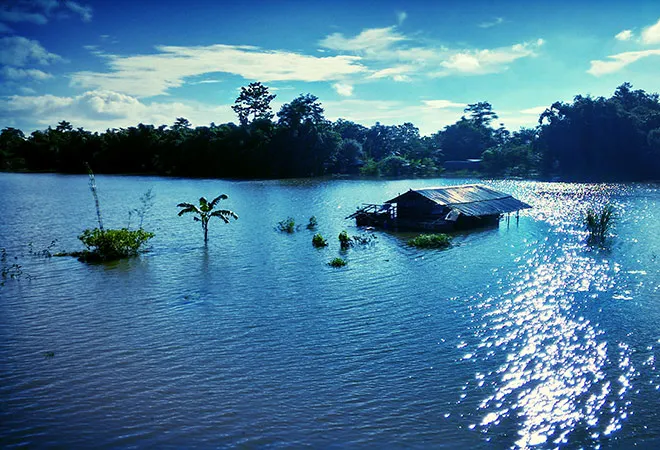-
CENTRES
Progammes & Centres
Location
A comprehensive strategy that includes a mix of crisis response and impact mitigation, while also taking into account urban and rural planning, livelihood issues and health perspective, is needed to mitigate the Northeastern State’s agony.

The deluge that hit Assam recently has left 33 districts badly affected. It caused miseries to more than four million people and thousands of acres of land were submerged by floodwater. Around 18 deaths were reported and more than one lakh people were rescued. The Kaziranga National Park, a world heritage site, which is famous for one-horned rhinos, too, had to face the wrath of mother nature. As an immediate response to the flood situation, the state Government pressed in relief and rescue operations for the flood victims without delay. The Central Government, too, released 250 crore as relief to the state. Floods in this state have become a perennial problem. Given their perpetuity, apprehensions have been raised about the Government’s approach in addressing the issue. Largely, the public perceives its action plan to be an emergency response than having a mitigating impact. Dealing with flood requires a holistic approach.
Assam is famous for its rivers — Brahmaputra and Barak — with their tributaries traversing the length and breath of the state. People in this state have a unique relationship of love and fear with the river. The rivers bring joy to them as they have special influence on the socio-economic lives of the citizens. Hence, floods make people fear the rivers.
The simplest explanation for flooding is heavy rains. However, a close look suggests that floods are caused due to both natural and man-made causes. The mighty Brahmaputra, the primary river, flows from the Tibet and carries with it loads of sediments, thus depositing silt on its bed. Deforestation in the hilly areas, primarily because of Jhum (shifting cultivation), a common practice in the hilly regions of the eastern Himalayas, is the reason for sediment load in the river. The rivers also carry a large quantity of water due to excessive raining in higher reaches. Due to heavy silt deposits, the rivers are unable to hold off the access water and, thus, spill over in the catchment area. Other prominent causes of floods include drainage congestions and encroachment of the riverine areas among other things.
Traditionally, the construction of embankments has been a prominent measure to control the floods. These resulted in the establishment of human habitats in the flood plains. Unfortunately, the maintenance of these embankments has not been satisfactory. On several occasions, these barriers fail to withstand the pressure of water and break, thus increasing the severity of impact. The establishment of habitats in the flood plains also brings humans much closure to the river and this increases sufferings of the people.
Floods impact people both economically and emotionally. They are also one of the reasons for poverty. A large portion of the state’s population is involved in agriculture and for a significant time of the year, they remain unproductive since vast tracts of agricultural land remains under water. Additionally, flood injects a feeling of insecurity among the people. The fear of becoming homeless is the most prevalent, especially among the poor. A major cause of worry is the destruction of houses during floods because they are mostly thatched and cannot withstand the raging water.
Rebuilding houses becomes another challenge for locals even as their economic condition deteriorates. Their agony further deepens due to soil erosion. Assam lost around seven per cent of its land due to soil erosion since 1950. Majuli, the world’s largest river island and a centre of Assamese cultural heritage, is faced with the threat of disappearance due to soil erosion. Besides, floods increase the risk of an epidemic and it also implies health concerns.
Controlling flood is a necessity for the development of the state, requiring short and long-term measures. Short-term prescription includes confining the flow by embankments, anti-erosion measures, dredging the river as a siltation management measures and drainage development works. Most common long-term measures suggested include the building of a reservoir in higher areas and relocation of the people in higher grounds. Such a measure will require large resources and is, of course, a time consuming process.
It is time for the government to look for alternative ways to address the flood problem. A new approach must consider blending of crisis response and impact mitigation. Flood should be at the centre for developmental planning. Assam’s flood management should include urban and rural planning, livelihood issues and health perspective. Notably, Assam’s floods management measures require sustained monitoring to attain success.
This commentary originally appeared in The Pioneer.
The views expressed above belong to the author(s). ORF research and analyses now available on Telegram! Click here to access our curated content — blogs, longforms and interviews.

Joyeeta Bhattacharjee (1975 2021) was Senior Fellow with ORF. She specialised in Indias neighbourhood policy the eastern arch: Bangladeshs domestic politics and foreign policy: border ...
Read More +